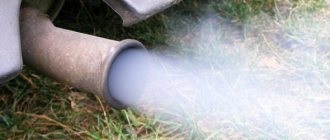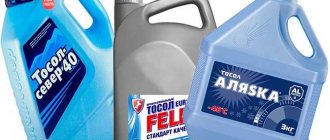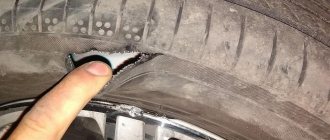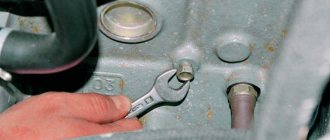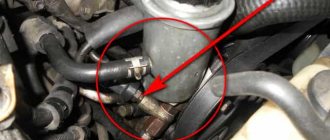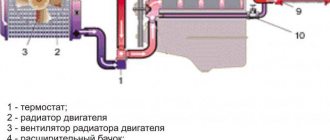Reasons for the formation of water and steam in the muffler
During operation, internal combustion engines (ICE) of cars heat up to a high temperature; heat removal is provided by the cooling system, but the exhaust tract remains quite hot. So, for example, the exhaust manifold and reception pipe, located in the immediate vicinity of the power unit, can heat up to 500-750ºC, pipes far from the engine, mufflers and resonators do not heat up so much, but the heating here is still very high.
After the engine stops, the steam remaining in the exhaust pipes settles on the walls of the iron, cools down and turns into water. It is for this reason that when a cold engine starts, you can see water splashing from the exhaust pipe; even as it warms up, the car begins to steam (white smoke comes out). But with a working engine, this phenomenon can only be observed when the internal combustion engine is cold; when warmed up to operating condition, all these signs should disappear.
Water from the muffler: reasons
There are 2 reasons why water drips from the muffler. Condensation can appear from the outside - when snow and rain penetrate into car systems. In the second case, moisture forms directly in the exhaust, since any engine runs on a fuel-air mixture.
A hot engine produces steam, the amount of which increases due to sudden temperature changes.
Condensation can also accumulate in other vehicle systems:
- In the engine itself. White deposits at the neck are traces of condensation.
- Near the valves (due to gasket damage).
- In the lubrication system (due to refrigerant).
- In the fuel tank (due to the use of low-grade fuel).
Try to keep the tank filled to the brim and park the machine indoors. Then the risk of moisture in the tank will be minimal.
Moisture inside the car is a big problem, because it may not reach the muffler, remaining invisible.
The liquid will significantly accelerate the wear of the elements. Therefore, it is worth regularly checking the engine compartment and undergoing maintenance in a timely manner.
The presence of condensation in the fuel tank can be determined by difficulty starting the engine or by engine interruptions. Moisture gets inside the tank along with low-quality fuel.
When refueling, look at the price of gasoline or diesel fuel. If it is significantly lower than the market price, be wary and do not rush to rejoice. The octane number is easily increased synthetically, using additives. Therefore, it is better to go to proven, branded gas stations.
Experienced motorists try to always keep the fuel tank full. This is not a whim, but an opportunity to avoid the appearance of condensation even with low-grade fuel. There is simply no room left for moisture inside the tank. Conversely, regular partial refueling helps retain moisture in the gas tank and other car systems.
There is no less trouble with condensation in the engine. It comes here from the fuel tank. A sign of a problem is excessive heating of the motor. You need to inspect the car for leaky gaskets or valves. If there is moisture on the internal combustion engine itself, this can be determined by grease stains on the engine body. The oil mixes with hot air, evaporates, and settles as condensate.
You can get rid of moisture in the tank and engine by using chemistry - special enzymes dissolve in water. Compounds are formed that easily burn out during engine operation without causing damage to the engine installation.
Water is more likely to form in cars with modern exhaust gas treatment systems. Condensation may leak from the muffler while driving. It occurs in the catalyst, which oxidizes platinum, palladium and other harmful compounds coming from the engine. As a result of the reaction, carbon dioxide and water vapor are formed, which remains on the walls of the pipe.
Is it possible to eliminate a water leak from the exhaust pipe?
When warming up in the autumn-winter and early spring, water comes out of the muffler quite often; moisture accumulates especially actively in the exhaust during short trips (it does not have time to evaporate). Another thing is that if steam continues to swirl on a well-heated internal combustion engine, there is cause for concern. Signs of a malfunction in this case may include:
- antifreeze boiling in the expansion tank;
- reducing the liquid level in the cooling system;
- uneven operation of the internal combustion engine at all speeds (engine trouble);
- the appearance of thick steam and drops of moisture from the exhaust pipe during re-gassing;
- temperature increase on the sensor is higher than the permissible norm.
To eliminate the defect, it is necessary to remove the block head and perform diagnostics using a visual inspection. As a rule, a broken gasket is immediately visible; in order to diagnose the cylinder head, a pressure test is performed. Also, the surface of the cylinder head adjacent to the cylinder block may be deformed; in garage conditions, it is checked with a caliper or the even edge of a metal ruler and a feeler gauge for adjusting the valves; if deformed, it is better to level the plane on a milling machine.
If water gets into the muffler naturally (condensation has accumulated), it is unlikely to be completely eliminated. But you can still reduce the release of steam and moisture during warming up like this:
- try to at least sometimes make not only short, but also long trips;
- make small holes in the resonator (muffler) for condensate to escape;
- Carry out a sufficiently long period of accelerating on a warm engine before turning it off.
It should be noted that on some cars, holes for draining condensate in resonators (mufflers) are provided by the manufacturer, so there is no need to modify such elements.
What to do if condensation appears in the car exhaust pipe
Climatic conditions and the operating principle of the internal combustion engine cause the formation of condensed steam in the exhaust gas exhaust system. To evaporate it, it is enough to take a long trip lasting more than an hour once a week.
You need to go to a service station for diagnostics if the exhaust gases have bluish or black smoke, a large amount of soot settles on the walls of the pipe, or there are malfunctions in the functioning of the cooling system or engine.
Article on the topic: Knocking in the Engine - all the reasons for the appearance of strange sounds when the engine is running
Is it possible to drill a muffler?
The procedure is ambiguous. On the one hand, liquid is removed from the exhaust system through the holes, on the other hand, two problems arise:
- the exhaust sound becomes louder;
- an element made of ordinary steel fails prematurely.
Under the influence of high temperatures, reagents, and moisture, a small hole will steadily increase. The same thing will happen with a stainless steel part, but at a slower pace.
Instead of drilling into the muffler, experts recommend that car owners create conditions that will prevent the formation of condensed steam in significant quantities.
Condensation in the muffler in summer
It’s clear where water accumulates in the muffler in winter and autumn, but why does condensation accumulate in the exhaust system in summer? The answer is quite simple: in the summer there are temperature changes, precipitation occurs, and in some regions there are cold snaps and even sometimes frosts. In dry, warm weather, practically no steam comes out of the muffler pipe, but this does not mean that condensation does not occur. After all, some part of the water in the pipes and “outlet” banks still precipitates, it’s just that on a clear day the steam is not so noticeable in the sun.
Why does condensation appear in the muffler?
The formation of condensation in the muffler is considered normal. However, so much of it accumulates over time that it becomes noticeable by the fact that condensate begins to flow out of it abundantly. Especially if condensation from the muffler begins to come out in copious splashes or gurgle while the car is shaking when driving off-road. There is, of course, little pleasant in this behavior of the car. As a rule, a large amount of moisture accumulates in the device during the winter period. At this time, the water often changes its state. In summer, water also accumulates in the muffler, but in smaller volumes. Despite this, drops of condensation are visible much more clearly in summer. In addition to the muffler, condensation may appear in the interior and other parts of the car during operation. in some cases it is absolutely harmless, but there are also situations where condensation can become an unpleasant factor that can provoke the development and spread of corrosion, which can simply lead to the formation of rust on parts or their rotting.
Making holes in the muffler (resonator)
When the engine is in good working order, the formation of condensation does not cause serious problems, except for one point: the moisture accumulated in the muffler cans, which remains inside for a long time, contributes to the formation of rust, because of this, the elements of the exhaust system may fail earlier. Of course, a lot depends on the quality of the metal, but on budget cars the “exhaust” parts rust quite quickly.
It’s easy to make holes in the “silencing” can; it’s convenient to do the work in a pit or on a lift in a garage where there is electricity. To do this you will need an electric drill and a drill of approximately 1.5-2 mm, perform the operation as follows:
- we go down under the car (raise the car on a lift), find the rear muffler can, use a drill and drill to make a hole (preferably at the lowest point);
- It is necessary to operate the drill very carefully, since when drilling metal, water almost always begins to flow out, so the power tool must be put aside in time;
- You can also make a second hole from the bottom on the other side of the can; by the way, on some cars mufflers with two similar technological holes can be installed.
Some car owners believe that after drilling, the metal will begin to rust more intensively in this place and the service life of the exhaust system will be reduced. But this issue is controversial, since it is not known what will cause the muffler to rot faster: from the water inside or from the hole made. Although the average service life of exhaust parts is approximately three years, exhaust pipes on more expensive cars usually last longer.
How to prevent the muffler from freezing
The best way to get rid of car exhaust pipe icing problem is regular prevention. Every day it is recommended not only to inspect the car for the presence of ice on the muffler, but also to prevent this by blowing the condensate that has formed from the exhaust system. To do this, just start the car, raise the speed several times to blow out any existing condensation from the exhaust system, and then you can turn off the engine.
It should be noted that at very low temperatures it is necessary to accelerate the schedule for blowing condensate out of the vehicle exhaust system. For example, if the outside temperature is below -30 degrees Celsius, it is recommended to start the engine every 12 hours and blow out the condensate that has formed.
( 410 votes, average: 4.56 out of 5)
Where is the engine number under the hood?
Is it possible not to turn off the engine at a gas station?
Related Posts
Features of modification of the muffler for condensate drainage
Not all mufflers rust quickly; there are even inexpensive car models on which the rear canister can last up to 10 years without modification or any repairs (for example, Renault Logan). The metal of the exhaust system on Chinese cars most often succumbs to rust, this applies to Chery, Lifan, Great Wall cars. Also, many non-original spare parts do not last long, so they all need improvement, and draining the water would not hurt. Why the holes are made at the very back of the can, at the bottom and of a certain diameter, is easy to explain:
- if you drill closer to the engine, exhaust gases will partially enter the cabin, which will certainly cause a lot of inconvenience and trouble for passengers and the driver;
- with larger diameter holes, an additional sound of a growling muffler will appear (although some people, on the contrary, like the sound);
- at a higher level of drilling, the water will not completely leave the can, and the rusting process will continue.
Character of smoke from the exhaust pipe
If there is condensation in the exhaust system, water flows out of the rear pipe and steam (white smoke) comes out, but the color of the exhaust gases may be different, and this clearly indicates a malfunction in the car. So, what could the color of the smoke mean:
- bluish, coming out of the muffler in thick clouds, indicates wear of the parts of the cylinder-piston group, the occurrence of piston rings;
- black, indicates problems with the fuel system and high fuel consumption.
If a car smokes slightly with a bluish tint, and usually immediately after starting the internal combustion engine, the cause of this malfunction is mainly “stiffened” valve stem seals. Smoking of this color when the car shifts to a lower gear and with the gas revved up is “tired”, does not hold up, the piston rings are stuck, which is why the oil is consumed to a large extent, although the engine may not lose power. If the engine has a turbocharger, the turbine may also be faulty.
Black smoke in any case indicates poor (incorrect) combustion of fuel; depending on the type of engine, the cause of the defect may be:
- clogged fuel injectors;
- defective air flow sensor;
- carburetor overflow;
- jammed internal combustion engine valves;
- unregulated high pressure pump (for diesel engines);
- clogged air filter.
In case of black and gray smoke, it is necessary to carry out diagnostics, find out the cause of the breakdown, and the car should not be operated with such defects.
Water and smoke from the exhaust pipe
If, after your car has fully warmed up, you notice that water is still dripping from the exhaust pipe and white smoke is coming out, then check to see if the muffler smells like burnt hot oil. If such a smell is present in the exhaust pipe, it may indicate damage to the pistons in the engine or worn piston rings. But the worst thing is when the exhaust starts to smell like maple syrup. In this case, it may indicate more serious problems with the engine. As a result, you need to take the car for a comprehensive diagnosis to mechanics.
Condensation in a car exhaust system occurs when cold and hot air mix. Dripping water from the muffler always frightens a novice car owner. Is it so scary and what negative consequences could there be?
Freezing of the muffler due to the accumulation of condensate in it
If the car is left in an open parking lot in the cold in winter, a lot of moisture can accumulate in the exhaust system, and water often freezes in a low elbow and in a narrow place. As a result, ice blocks the passage of exhaust gases, problems arise with starting the internal combustion engine - the car will start, then immediately stall. In such cases, it is necessary to warm up or tap (clean) the exhaust tract, but in general there are several solutions:
- try to clean the pipe if ice has formed at the back (not in the elbow between the cans);
- tow the car to a warm garage or service station;
- warm up the “outlet” using a hair dryer;
- use the services of visiting specialists;
- take the car to a car wash to warm up the muffler using hot water.
Heating with an open flame (gas burner, blowtorch, etc.) is not recommended; all other methods can be considered. And in order to avoid the repetition of such cases, holes must still be made in the muffler, you should also gas the car to blow out condensation before parking, do this also when starting the car, park the car not on a descent, but on an ascent.
Moisture in the internal components of a car is a sign of the proper functioning of its main components. At the same time, there is no need to grab your head and rush to the nearest service station. After all, there can be no talk of any defect here. Although novice car enthusiasts are sometimes shocked when this moisture accumulates in a decent puddle. A reasonable question: why is there a lot of water in the muffler? This already depends on the ambient temperature, operating mode and fuel quality.
How to get rid of water in the muffler
Moisture should not actively accumulate inside the muffler. You can avoid its formation by following these recommendations:
- Increase the engine warm-up time if the engine has automatic warm-up. You can use a separate liquid heater if the muffler does not have time to heat up.
- Do not leave your car outdoors in winter.
- Use quality fuel. The low grade is all water.
- Place the car at an angle with the front end down after starting the engine. This method will reduce the intensity of corrosion on metal walls.
- Insulate the muffler (especially important for cold areas). Any non-flammable heat insulator can be used.
It’s worth making long trips at least once every 30 days (preferably in winter or autumn). This will make it possible to warm up the car and its exhaust system well. An hour-long drive along the highway at high speeds is the best way to remove excess moisture from the silencer. Short trips around the city do not give such an effect. This, on the contrary, is a destructive factor - the condensate will only have time to thaw and turn into water.
Is it possible to drill the muffler?
You need to drill the resonator, not the muffler itself. A thin 3mm metal drill is placed on the drill. Up to 250 ml of water can leak from the exhaust cans. The method is imperfect, but quite safe. Some drivers even use it on new cars.
The manufacturer does not recommend making holes in the resonator. The metal of the muffler quickly becomes unusable after this, because even a small hole is a potential source of corrosion. Due to high temperatures and dirt, the process of rust spreading becomes more intense. In addition, a leaky muffler makes a lot of noise and exhaust gases enter the cabin.
The lifespan of exhaust elements is 4-5 years. With regular use of the car - even less. When purchasing a new silencer, give preference to models with anticorrosive properties.
Every second driver in the Russian Federation is forced to solve a problem with condensation. The humid Russian climate is the reason for this. Be careful, monitor the amount of moisture. A small amount of water is not a problem. If there is too much of it, it is better to contact a car service, perform diagnostics and accurately find the source of the problem.
Moisture in the internal components of a car is a sign of the proper functioning of its main components. At the same time, there is no need to grab your head and rush to the nearest service station. After all, there can be no talk of any defect here. Although novice car enthusiasts are sometimes shocked when this moisture accumulates in a decent puddle. A reasonable question: why is there a lot of water in the muffler? This already depends on the ambient temperature, operating mode and fuel quality.
Where does water come from in a car exhaust system?
The reason for this is condensate - a liquid that has changed from a gas state due to cooling or compression. Its appearance is due to temperature differences: a muffler heated from the inside is not cooled as intensely as from the outside. In this case, moisture is formed only after the engine is stopped. As soon as the car stalls, dewdrops will begin to settle in the exhaust pipe. In winter, the accumulated condensate also freezes. So the ice build-up gradually increases, forming a traffic jam in the car muffler.
Physical processes of condensation formation
The composition of the fuel is the basis from which moisture appears inside the exhaust pipe. Gasoline is a mixture of light hydrocarbons. When burned, they produce a variety of gaseous substances, including water vapor. Regardless of the quality of the fuel, there will always be moisture in the muffler. But “premium” gasoline emits less water than cheap gasoline. At a certain air temperature, these vapors settle. This is how condensation forms: the exhaust pipe quickly cools from the outside, but the warm air remains inside for a long time.
Where does water come from in the exhaust system, reasons
The external environment and fuel are two sources of liquid formation in the exhaust pipe. There are always tiny droplets of water suspended in the surrounding air. When the internal combustion engine is running, the exhaust system heats up, so after stopping the engine, condensation forms on its hot surface. During fog, rain, and frost, this process is more intense.
As for fuel, its combustion process produces carbon dioxide, products of incomplete combustion and water. It will be removed from the muffler in the form of steam along with the exhaust. But the greater the difference between the air temperature and the exhaust pipe, the more steam condenses on the iron walls and turns into water after the engine is turned off.
Because of this, some amount of water always forms in the exhaust system of a working car. Splashes of moisture disappear, evaporation stops after the engine warms up.
At the same time, in some situations the presence of water should alert the vehicle owner.
Article on the topic: Reasons, nature of glow ignition
Water on a warm engine
At an air temperature of 10°C and below, within 20 minutes of warming up the engine in cars with automatic start, the frozen condensate turns into a liquid state. It does not have time to evaporate and, under the pressure of the exhaust gases, splashes out.
During short trips by car, some of the water remains in the system, and when it cools, another portion of condensate settles. Gradually the amount of liquid increases, creating a potential danger to the metal.
Black soot with water
Some of the products of incomplete combustion of the fuel mixture settle on the surface of the exhaust system, mix with condensate, and are released in the form of black drops when the engine starts. If the car is fueled with low-quality fuel, then soot is formed in large quantities.
The appearance of gray and black exhaust gases indicates serious car malfunctions. Gray-colored puffs indicate wear on the elements of the cylinder-piston group and the need to inspect the piston rings and valve stem seals.
Black smoke indicates a leak in the injector sealing rings or a malfunction in the ignition system.
Why does a lot of water collect in the muffler?
Noticing condensation dripping from the exhaust pipe, an inexperienced car owner either panics or is perplexed. Rushing to the nearest service station is not the smartest idea. Several factors contribute to the accumulation of moisture in the inside of the pipe. You need to understand them in more detail:
- driving in winter - the difference in temperature outside the muffler and inside it makes itself felt;
- infrequent use of the car - short short trips are fraught with increased condensation;
- modern exhaust gas purification – their design entails side effects.
When driving in winter
The cold season is the best condition for the formation of condensation in the muffler. The air temperature outside the exhaust pipe is much lower than inside it. So the moisture does not evaporate, but settles in a liquid state. Automatic warming up of the car partially solves the problem with condensation. But moisture still remains on the cold components of the exhaust system, because the idle speed is not so high as to blow it out with a stream of gases. Therefore, water settles inside the muffler, accumulating with each new heating.
When using the car infrequently
The shorter the trips, the worse the muffler warms up, which means less intense evaporation of moisture. It will settle inside the exhaust pipe in larger volumes than during long-term operation. Car owners who make long trips experience less difficulty with condensation in the muffler. The same cannot be said about those who use their iron horse only for short “home-work-home” forays.
In cars with modern exhaust gas cleaning systems
Due to the catalyst (emission system), condensation can flow while driving the car. A lot of substances come out of the cylinders and are sent to the exhaust manifold. The process is accompanied by the release of nitrogen oxides, carbon monoxide, unburned hydrocarbons, carbon dioxide, oxygen and water. Only the last three elements are harmless to humans. All the rest go to the car's catalyst, where they are oxidized by platinum and palladium. This is how carbon dioxide and water vapor are formed. The latter remains inside the muffler.
What is the danger of water in the muffler?
Natural transparent condensation is not a problem if there is little of it. It’s just water - its accumulation, on the contrary, indicates the serviceability of all systems. Things get worse if the moisture has an unusual color and thick black smoke appears.
Danger No. 1 - condensation can turn into ice. This threatens to rupture the muffler or resonator. In addition, when water freezes, important channels connecting the motor to other systems become clogged. Therefore, it is very difficult, almost impossible to start the car.
Danger #2 is corrosion. The internal cavities of the exhaust system quickly rust. For example, on the first VAZ cars, the resonators and pants rotted in almost 3 years, although they were made of durable steel. With a stainless muffler of foreign cars, things are somewhat better, but condensate can react with sulfur dioxide (present in the exhaust of any internal combustion engine), form acid and corrode the metal in 1-2 years.
Is condensation in a car dangerous?
Moisture settled in the muffler is a sign of proper operation of the internal systems of the car. Although such a phenomenon does not pose a radical danger, it would be thoughtless to turn a blind eye to it. The main reason for this is corrosion. Experts at domestic service stations claim that exhaust gases are no less aggressive than condensate. But water in a car muffler is still a potential threat, just like any metal liquid. The same applies to the gas tank, engine, and interior - in these places moisture sometimes accumulates in the same volumes as in the muffler.
In addition to the fact that water will splash spectacularly from the exhaust pipe, the car owner will also face a banal inconvenience. During a trip, few people will ignore the gurgling and “spitting” sounds made by the muffler, and in the cold season an additional nuisance appears - an ice jam. Frozen condensation can simply block the exhaust outlet, causing the car to not move.
Flooded spark plugs and other problems with an unheated engine
It's still worth warming up the engine in cold weather. If only because the driver does not lose anything except a small amount of time. In the cold season, when starting the engine, the fuel mixture becomes oversaturated with gasoline, which leads to a negative effect on the spark plug electrodes. Sometimes it can completely flood them. An unheated engine at high speeds will require more frequent replacement of spark plugs.
Modern cars have at their disposal the latest systems that monitor engine operation at low temperatures and more accurately control the level of injection of the fuel mixture. This amount automatically changes with temperature fluctuations.
Many people observe the following picture: liquid dripping from the exhaust pipe. No need to worry, some time after starting the engine in the cold
, this is a normal phenomenon that should disappear after a few minutes of engine operation. In any case, a cold engine should not be subjected to heavy loads; even if you drive, it is recommended to drive the first kilometers at minimum speed.
How to prevent liquid from appearing in the exhaust pipe
Whether it’s a luxury car or an old car, this will not protect you from the laws of physics; condensation forms in all of them. The same applies to the quality of gasoline - there will be moisture in all brands, albeit in different volumes. But if water gets into the muffler, then effective recommendations should be followed. Tested by time and practice, they will help get rid of condensation:
- Store the car inside the garage when cold weather sets in. Many car owners prefer to leave their vehicles in the cold, not wanting to waste time walking from home to garage - in winter this is a gross disrespect for their car. If you park it in a warm room at night (for example, in a garage), then in the morning it will take less time to warm up.
- Auto warm-up This feature is available in most modern cars. It is important to set it up correctly so that the muffler warms up along with the car. Otherwise, there is no guarantee that even when this system is activated, the exhaust pipe will not be clogged with icy condensate. This applies to both cars with injectors and carburetors - however, the latter warm up more slowly.
- Pay attention to the parking spot. If the car is parked on a slope towards its muffler, then water flows out of it faster.
- Arrange at least weekly long trips. This is an effective prevention against the formation of an ice plug from frozen moisture.
- Insulate the exhaust pipe of a car if there is neither a garage nor a heating function. Non-flammable heat insulators or liquid heating are suitable for this.
- Change gas station. Poor quality fuel also contributes to the formation of condensation inside the muffler.
- Drill a tiny hole in the resonator. An old and controversial method that ensures the free flow of water. The disadvantage of this method is that this same hole will serve as a catalyst for the development of corrosion.
Condensation in the exhaust pipe: where does the water come from?
“Why isn’t this scary?” - you ask. Yes, everything is simple, the exhaust from the engine is very hot (about 500 - 550 degrees Celsius), and even when it meets the catalyst (which burns the exhaust gases), it heats up to 800 - 900 degrees (and the rear resonator warms up to about 90 - 110 degrees.
It seems that there are no problems and everything is deleted by itself. Actually, in the summer and during the hot period of time, this is exactly the case (in the summer it is hot outside and even from an idle car, all the moisture can evaporate). BUT not everything is so happy. During cold periods, the car does not have time to warm up the exhaust system, especially in severe frosts and short trips. And therefore moisture begins to accumulate more and more. And it's really bad
The only danger of condensation accumulating in the muffler is that the muffler will gradually begin to rust from the inside. But this applies to inexpensive mufflers. If the car is normal, then the muffler is well protected from corrosion from the inside.
But if condensation accumulates not in the muffler, but in other components, this is already a cause for concern. By the way, condensation can often accumulate in the gas tank. Especially if you refuel with low-quality gasoline. Also, if the car spends the night not in the garage, but on the street, then water will naturally accumulate in the tank.
Read more: TOP 10 least stolen cars in Russia
It is not so easy to pump water out of the tank, and it will be at the bottom of the tank, since it is heavier than gasoline. To remove water from a gas tank, you can pour alcohol into the tank, which will mix with water and the density of such a mixture will be the same as gasoline, so the water will easily come out along with alcohol and gasoline through the fuel line and the engine will not be harmed by this. In addition, water can be sucked out of the gas tank using a tube.
There are several ways to prevent condensation from forming in the muffler. It is almost impossible to completely eliminate the formation of moisture in pipes, but you can reduce the volume of water. To do this you need to follow a number of simple rules:
- If possible, always leave the car not in an open parking lot, but in a garage or indoors;
- If the machine is equipped with an auto-warm-up function that operates several times during the night, it is recommended to increase the warm-up period. This will ensure that all the ice in the pipe melts and the water evaporates;
- use only high-quality fuel at proven gas stations;
- when replacing a muffler, buy new pipes with anti-corrosion coating;
- insulate the muffler with thick pieces of heat-resistant materials.
In winter, none of these measures can fully protect the muffler from condensation, since you will have to warm up the car too often and spend a lot of fuel. You can only reduce the amount of moisture.
Video
Found an error in the text? Select it, press Ctrl + Enter and we will fix everything!
Almost every motorist faces the problem of condensation in the muffler and, as a result, leakage of water droplets from the exhaust pipe. This phenomenon, which is relevant both in winter and summer, often leads car owners to suspect that there are problems with the systems. At the same time, the formation of steam and leakage of liquid, being a normal physical process, does not always indicate a malfunction. Condensation can collect on new cars in the same way as on those with decent mileage, and in most cases does not cause any damage, so most often there is nothing to worry about. But if the leaking liquid has an unusual color or clouds of white smoke come out of the pipe, then this is a reason to think about it and go for diagnostics.
How does moisture get inside the muffler?
We regularly encounter the phenomenon of condensation in everyday life, and it is always undesirable, no matter where it occurs, and sometimes it can act destructively on structures, being also one of the provoking factors for corrosion. Every schoolchild knows from physics lessons where condensation comes from, and if water begins to flow out of the muffler, which can most often be detected when starting a cold engine, then this is not a sign of design defects. Let's take a closer look at why water drips from the muffler, which promotes condensation. The reasons for the formation of condensation in the exhaust system of a car lie in physical processes, as well as chemical reactions occurring in the internal combustion engine chamber:
- Droplets settle on surfaces or inside structures, falling out of the air, since the content of water vapor in it depends on temperature. Condensation as a result of contact of hot elements with cold air outside the car is a normal phenomenon. When the temperature drops to the dew point, excess moisture always settles in drops on objects, so the heating of the motor and the contact of heated elements with cold air is the main cause of condensation. The lower the temperature, the less the air retains moisture in a gaseous state, which explains the fact that in winter condensation appears more actively, which is why water comes out of the exhaust pipe. In the cold season, the transition of water from one state to another is observed much more often, and icicles hanging from the end of the muffler are also the result of normal natural processes. In summer the problem is less noticeable, but still occurs. Condensation in the muffler collects more intensely when the air is saturated with water vapor, as in times of rain and fog, as well as during significant temperature differences;
- Water is also released as a result of the chemical reaction of fuel combustion (gasoline, diesel fuel or liquefied gas). During the combustion of the mixture, the reaction of carbon and hydrogen with oxygen forms carbon dioxide and water vapor, which is emitted through the exhaust system, partially settling there in the form of condensate;
- Water vapor is also formed during the afterburning of gases in the catalytic converter. Unburned carbon monoxide, along with the exhaust, goes straight to the catalyst, where it undergoes oxidation. The steam burns out, resulting in the release of water.
How to remove water from the muffler
There are several ways to remove water from the muffler and prevent its massive formation.
The simplest and least dangerous way is to dry the muffler by heating it up. As mentioned above, during engine operation, the temperature of the muffler increases significantly, which leads to the conversion of accumulated water into steam. That is, in order for the muffler to warm up enough and have time to get rid of water, you need to either minimize short trips by car, or make long trips from time to time so that during this time the muffler has time to get rid of excess water.
It is especially important to take long rides to get rid of water during the colder months. At least once a month in winter, spring and autumn, it is necessary to make trips lasting at least an hour, preferably at high speed - that is, on the highway. During this time, the exhaust gases will have time to heat up the muffler, and the water will evaporate.
A difficult way to get rid of water in the muffler is to drill it. If you decide to take such measures, you should know that you need to drill the last “can” of the resonator with a thin drill (about 2-3 mm).
Please note: You can find advice online that it is necessary to drill holes in all (or almost all) resonators in order to get rid of water completely. We do not recommend doing this.
The method of removing moisture from the muffler by drilling holes itself is quite controversial. There are several negative aspects that it leads to:
- Hole formation. Even if the work is carried out with a thin drill, the surface of the resonator will still be damaged. Over time, elements of corrosion will begin to appear on it, and a small hole will begin to grow;
- Exhaust gases entering the cabin. If you drill several “cans”, then there is a high risk that the exhaust gases will partially begin to be directed into the car’s interior;
- Change in exhaust sound. The noise from the car's exhaust may increase, or the sound will become louder, which may generally cause discomfort.
( 158 votes, average: 4.47 out of 5)
How to remove broken spark plugs yourself
Do I need to change springs every time I replace shock absorbers on a car?
Related Posts
Consequences of condensation release
Due to frequent use of the car, the liquid simply does not have time to evaporate; as the unit warms up, steam begins to be released, and then water drips from the exhaust pipe, but with the engine in full working order at the desired temperature, the problem should disappear. Condensation that naturally accumulates in the muffler is not as dangerous as it might seem at first glance, although it does not bring any benefit. The consequences of its presence in the exhaust system are as follows:
- When a car is parked in open parking lots in winter at sub-zero temperatures, the liquid inevitably freezes. A crust of ice appears in the pipe, which can partially or even completely block the passage, preventing the exhaust gases from escaping. The exhaust gases, returning, deplete the fuel mixture, as a result of which the car may simply not go anywhere. An ice jam is a rare occurrence; usually, leaving a car in the cold leads to the formation of icicles on the pipe;
- Freezing of water reduces the service life of parts of the exhaust system; as a result of expansion caused by the appearance of ice, a pipe or resonator may even rupture;
- Moisture plays an important role in the onset of corrosion, but rust is caused not so much by the liquid accumulating in the muffler, but by other reagents contained in the exhaust and having an aggressive effect.
Since the exhaust system can be made of different materials (ferrous metal, aluminum, stainless steel), it will serve differently. Stainless steel is the most durable; subject to natural exposure to moisture and exhaust gases, the pipe will last up to 100,000 km. vehicle mileage.
Why is water in the muffler dangerous?
Water in the muffler is dangerous in both cold and warm seasons. In the summer, this threatens with trivial problems - the formation of corrosion on elements: the internal walls of resonators, pipes, etc. At the same time, even if the muffler and components are made of stainless steel, this will not save it from problems, since the exhaust contains a lot of different impurities, including sulfur dioxide. Mixing with water and settling on the muffler elements, it leads to the formation of small amounts of sulfuric acid, which, over time, can corrode, including stainless steel.
Please note: If the muffler is made of steel (for example, as was done on Russian cars produced before the 2000s), it can completely rot due to accumulated water.
In winter, the presence of water in the muffler is even more dangerous. As a result of water freezing and expansion, a part of the muffler (pipe or resonator) may rupture. In addition, after a long period of parking, ice can clog the outlet for exhaust gases, which will lead to problems with starting the engine and a lean fuel mixture.
When to be wary
There is no need to immediately ring the alarm bell and go to the service center when you see water flowing from the exhaust pipe. Motorists' fears are largely unfounded. You only need to worry in cases that predict problems with the engine:
- Excessive leakage of water;
- After warming up the engine and exhaust system, condensation does not stop;
- Drops of water are black in color and leave oily stains;
- Along with the liquid, thick white smoke comes out of the pipe.
The presence of strong condensation, accompanied by white puffs of smoke, indicates that the cylinder block gasket has worn out, then it must be replaced immediately. A breakdown causes antifreeze to enter the cylinders, which evaporates and is released into the exhaust system. Meanwhile, the coolant level drops noticeably. The black color of the condensate indicates a large amount of soot settling on the walls of the muffler for the following reasons:
- Using low-quality fuel (soot can completely clog the system and prevent the unit from starting). Sometimes, when using low-quality fuel, the condensate has a yellow-green color, indicating a high sulfur content;
- Violation of the combustion process of the air-fuel mixture. This can be caused by wear of the cylinder-piston group, problems with the ignition system, lack of proper fuel supply and other malfunctions of the participating elements.
Oily discharge from the muffler may indicate wear of the cylinder-piston group or valve seals, since the engine oil entering the cylinders burns along with the fuel and is partially directed to the exhaust gas exhaust system. The smoke from the chimney acquires a bluish tint, and the malfunction is also characterized by signs of carbon deposits on the spark plugs and increased consumption of engine lubricant.
Why is water dripping from the exhaust pipe?
In sub-zero starting conditions, the combustible mixture becomes oversaturated with gasoline, which often leads to flooding of the spark plugs. When the engine is not warmed up, this phenomenon is observed constantly and leads to the need for frequent replacement. Modified cars are free of this drawback, as they are equipped with systems that control fuel injection, which changes with the slightest fluctuations in environmental parameters.
The cause of moisture getting into the exhaust pipe may be low-quality gasoline. Excess water from the fuel tank seeps into the exhaust line and then into the engine itself. In the latest models, designers have improved the technology, thanks to which this flaw is eliminated.
A serious cause for concern is a water leak accompanied by a thick cloud of gray or blue-white smoke. Various systems, a distribution mechanism or a cylinder-piston group can act as a provoking source. The search for a defect is carried out by assessing the nature of the smoke, its intensity and the presence of accompanying phenomena, for example, knocking. There is no need to worry if white smoke appears; it is most likely steam, which disappears completely as the car warms up. At a temperature of -10°C with a warm engine, white smoke will come out of the exhaust pipe; at -25°C it will take on a bluish tint. At the same time, a pattern is observed: the higher the air humidity, the thicker the gas cloud.
If a similar picture is observed in the summer, then this indicates that liquid in the form of antifreeze or antifreeze has entered the cylinders, possibly due to depressurization of the blocks, cracks in the head or in the cylinders themselves. The origin of the vapors after the engine has warmed up can be determined using white paper attached to the exhaust pipe. If oil stains remain on it, then the cause must be sought in the expansion tank or in the radiator. A burning smell and a decrease in coolant level may suggest a solution. In any case, diagnosis cannot be avoided.
Conclusion
It is not recommended to subject the car engine to sudden excessive loads and it is advisable to cover the first kilometers of the journey at minimum speed. Liquid dripping from the exhaust pipe should not cause concern, however, in rare cases it can still warn of internal problems in the system.
subscribe to the channel and like, thank you all!!!
by z drive. Yandex Zen.
- Why are tram and trolleybus drivers women?
- What is the difference between a chauffeur and a driver?
- Digital service booklet - goodbye to tangible service history
How to deal with water in the muffler and is it worth doing at all?
Condensation is a common phenomenon that occurs in the systems of all vehicles, regardless of manufacturer or model. There is no point in fighting natural dew; water will accumulate in the muffler, no matter how hard you try. The main condition for the formation of droplets on surfaces is a decrease in air temperature to the dew point or even lower. The dew point is reached when the air humidity and the pressure of the contained water vapor are increased to their limit, that is, they are equal to the maximum value. So, to prevent this phenomenon it is necessary:
- Reduce the temperature difference between the air and the structure;
- Reduce air humidity;
- Provide conditions for rapid evaporation of water.
Among the methods describing how to get rid of a large accumulation of condensate in the muffler, motorists often use a barbaric option, which involves drilling holes in the resonator, which will remove excess water, but this will not solve the problem if problems arise with engine elements, and natural condensation can be reduced by more gentle methods methods:
- The car must be operated not only over short distances, but also over long distances;
- It is best to park the car in a warm garage with good exhaust ventilation;
- The automatic heating option often does not have time to heat the muffler to the required temperature, as a result of which moisture still appears. It makes sense to increase the warm-up time to solve the problem;
- Low-grade fuel can lead to a number of different malfunctions, and water leaking from the muffler is only a small part of the troubles associated with this, so it’s worth thinking about switching to high-quality fuel.
It will not be possible to completely protect against the appearance of condensation; all the considered actions are aimed only at reducing its amount in the system and promoting the rapid evaporation of water droplets. At the same time, in most cases there is no need to worry about condensation; as practice shows, only an abnormal color of liquid or smoke can indicate a malfunction.
The best prices and conditions for the purchase of new cars
What is the danger of water accumulation in the muffler?
The main danger that may lie in wait in this case is that over time the muffler may rust. In some cases, condensation may begin to accumulate in other components, for example, in the gas tank. Especially if you fill your car with low-quality fuel. With such a turn of events, it is quite difficult to pump out excess moisture from the tank. To at least somehow reduce the amount of moisture formed in the exhaust pipe, you can use these simple recommendations:
- Pump only high-quality fuel into the gas tank;
- Insulate the muffler with heat-insulating material;
- Make a hole in the muffler to allow water to drain out.
As for the latter, it is undesirable to do this manipulation. Corrosion will quickly develop at the hole, which will lead to the formation of loud noise from the muffler.
More information about condensate in the muffler will be discussed in this video:
Published: September 19, 2020
